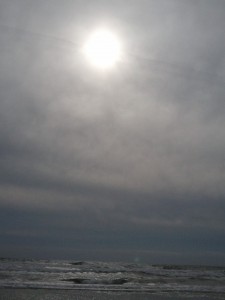At the end of 1951’s The Thing*, a reporter, cured of his cynicism, phones in his story from the Artic. He has a doozy – a small group of Americans, isolated from rescue, have destroyed a ‘thing’, an alien killer. The reporter issues a warning to his readers and to the audience: “Watch the skies everywhere. Keep looking. Keep watching the skies.” He is warning of an alien invasion – watch for the saucers. They’ll come from above. Look up. I loved that movie as a boy and still do. I thought the ending especially smart – it tries to guarantee a life for the movie once the audience has walked out of the theater. For a few days after their experience I’m sure they too looked up, warily. In the early 1960’s when I first watched this movie, I know I studied the day-lit and the evening skies. My imagination compelled me to do so, but then some of my earliest memories are of the sky – before that reporter’s voice crackled through our TV’s speakers, something about it had already clinched onto my imagination and stayed with me.
 I remember varieties of blue sky. Maybe my memory romanticizes that image, but I recall cornflower blue and cobalt, Carolina blue and Persian, violets and steel blues. The sky showcased speed and movement, its clouds tumbling into fractal forms whose styles I did not know then. Now when they come I know them by their marvelous names – the lowering solid grays of November stratiformis, the precipitatio that form in wavering downward lines beneath heavy clouds and signal rain falling to an observer miles away, the clear weather cumulus, shape-shifters of every childhood, the incus of thunderheads.
I remember varieties of blue sky. Maybe my memory romanticizes that image, but I recall cornflower blue and cobalt, Carolina blue and Persian, violets and steel blues. The sky showcased speed and movement, its clouds tumbling into fractal forms whose styles I did not know then. Now when they come I know them by their marvelous names – the lowering solid grays of November stratiformis, the precipitatio that form in wavering downward lines beneath heavy clouds and signal rain falling to an observer miles away, the clear weather cumulus, shape-shifters of every childhood, the incus of thunderheads.
I grew up among creeks, rivers, woods and fields, and my parents let us wander. My friends and I were often caught out in storms. We sheltered under bridges, in open garages and in abandoned farmsteads surrounded by open fields and watched thunderheads roaring in upon us, evolving purples like a bruise traced along a thigh. Those storms filled every part of the sky. Even while afraid, who does not love to watch them?
 Before Sandy arrived, my wife and I stood on a beach at the Jersey shore; the most distant clouds of the storm had begun to arrive and they layered the sky in luminous grays. Just above the rising surf, three hundred yards out, streams of Scoters, one after another after another, like hurtling black dots, raced south, thousands of them. One man on a paddle-board, clothed in a wet-suit, stood in the center of dolphins. They were arching smoothly all around him, feeding and circling.
Before Sandy arrived, my wife and I stood on a beach at the Jersey shore; the most distant clouds of the storm had begun to arrive and they layered the sky in luminous grays. Just above the rising surf, three hundred yards out, streams of Scoters, one after another after another, like hurtling black dots, raced south, thousands of them. One man on a paddle-board, clothed in a wet-suit, stood in the center of dolphins. They were arching smoothly all around him, feeding and circling.
Sandy came inland upon punishing winds. Sitting on the stoop I saw a fist of birds, starlings probably, alight in a tall tulip poplar and become anchored in its pendulum swings. Three dashing crows rode the gusts. A black and white warbler escaped to the chrysanthemums on the porch and looked stunned to have made it that far.
I expected to lose at least one of our big maple trees. All three, fully leaved, seemed to come apart from the trunk up — all the heavy branches flipping away and in, up and across, looking like old women in shawls and long dresses, their backs to me, throwing their arms above them and wildly gesturing. In full darkness enough ambient light remained to outline them against the sky and their gestures grew more desperate, crazier, the way any living creature that will not rest seems unhinged.
The command to watch the skies has shifted from boyish days when strange ships carrying ogres might hover into view. Now it means that looking up and turning and turning with the horizon line brings surprises that exalt because they forever ebb and flow.
*A movie with funny, snapping dialogue, well-shot and edited action sequences and good performances. It remains fresh.